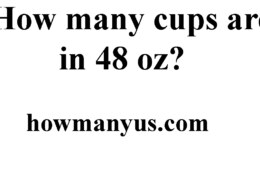How many cups are in 48 oz?
The question “How many cups are in 48 oz?” seeks to convert a measurement in fluid ounces (oz) to cups. This type of conversion is common when cooking, baking, or preparing beverages, where different units of measurement are used for liquids. Understanding how to convert between ounces and cups is essential for accurately following recipes and portioning ingredients.
In this context, fluid ounces (oz) and cups are both units of volume measurement used in cooking and baking. Cups are a familiar measurement in recipes, especially in the United States, while fluid ounces provide a more precise measurement for liquids.
How many cups are in 48 oz?
Context and Significance:
The significance of converting 48 fluid ounces to cups lies in its practical applications in the kitchen:
- Recipe Preparation: Many recipes provide ingredient measurements in cups, while others specify liquids in fluid ounces. Converting between these units ensures accurate ingredient proportions.
- Beverage Serving: When serving beverages, understanding the cup-to-ounce conversion helps in portioning drinks appropriately.
- Cooking Accuracy: Precision in measurements is crucial for successful cooking and baking outcomes.
Converting 48 fluid ounces to cups allows cooks and bakers to use the appropriate volume of liquid ingredients in their recipes.


To convert 48 fluid ounces (oz) to cups (c), follow this conversion:
Step 1: Conversion Factor
Step 2: Calculation To find the number of cups (c) in 48 fluid ounces (oz), use the conversion factor:
Number of cups (c)=8 fluid ounces (oz) per cup (c)48 fluid ounces (oz)
Number of cups (c)=848
Number of cups (c)=6
Therefore, 48 fluid ounces (oz) is equivalent to 6 cups (c).
Practical Application: Knowing that 48 fluid ounces is equal to 6 cups allows for accurate measurement and portioning of liquid ingredients in recipes. This conversion ensures precision in cooking and baking, resulting in successful culinary outcomes.
Conclusion: Converting 48 fluid ounces to cups simplifies ingredient measurements, making it easier to follow recipes and achieve desired cooking results. Understanding this conversion is valuable for anyone working in the kitchen, from home cooks to professional chefs.